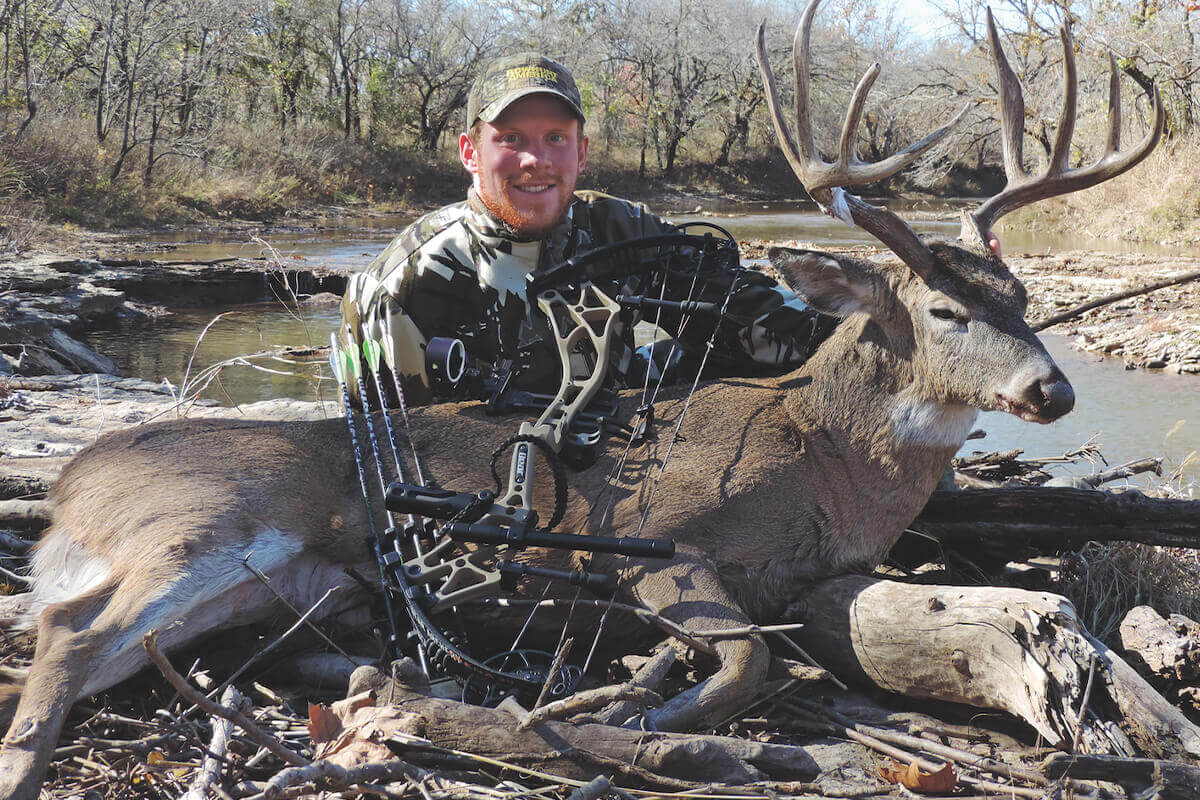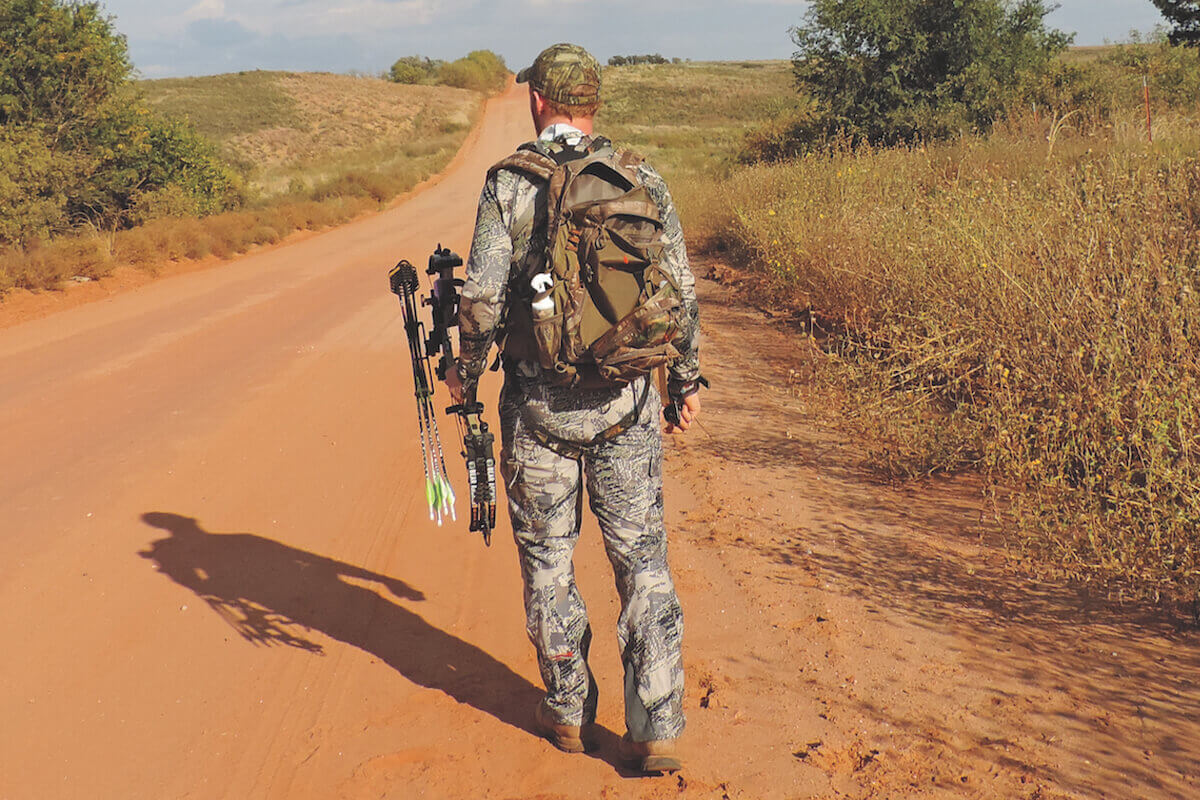
The author did his research and hunted a WMA to bag a long-tined tallgrass trophy. (Photo by Darron McDougal)
This article was featured in the November issue of Game & Fish Magazine (South edition). Click to subscribe
With temperatures reaching 93 degrees, conditions inside the ground blind were sauna-like. Despite the heat, my guide assured me that it’d be a great evening. So, as sweat beads trickled down my back and forehead, I monitored the wide-open food plot in front of me, hoping one of the surrounding draws would manufacture a mature buck.
As darkness slowly swallowed the daylight, I knew I’d be picked up soon and my evening hunt would be over. Suddenly, a big, mature 8-pointer and another buck appeared on the skyline 150 yards away. I felt a wash of adrenaline coarse through my veins as they beelined for the feeder. Suddenly, there he stood, quartering toward me at just 30 paces.
Two minutes of legal shooting light remained when he finally turned. In that instant I released my arrow, sure it would be a winner. To this day I’m not sure what went wrong. When we found the arrow there was next to no blood on it and no blood trail to be found. We spent hours looking everywhere for that deer to no avail. Needless to say, I was sick. Since I’d made contact, my hunt was over. But I’d be back in Oklahoma in November for another chance.
For the next month, I researched Oklahoma wildlife management areas for my next Sooner State hunt. The one I chose was some 200 miles from where my October hunt had unfolded. Three days in, I arrowed my then-best whitetail, a 150-inch-plus beauty. He is a tremendous trophy, especially since I took him the first time I hunted that particular WMA.
Oklahoma’s geographic location—sandwiched between whitetail meccas Kansas and Texas—is well-appointed to offer excellent deer hunting. According to QDMA’s 2020 Annual Report, 66 percent of bucks harvested in Oklahoma in 2017 and 2018 were 3 1/2 years old or older. This means that many bucks reach the age class that sees peak antler potential.
Some 4.6 percent of Oklahoma is public land. While that may not sound like a lot, in addition to sprawling national forests and grasslands, the Oklahoma Department of Wildlife Conservation manages more than 80 WMAs across the state. So, when visiting Oklahoma, you won’t struggle to find places to hunt. And, if a do-it-yourself hunt isn’t your thing, the Sooner State has many outfitters who offer a quality hunting experience.
From mountains to prairies, Oklahoma is a venerable ecological cornucopia with enormous biodiversity. Here are six of the best ecoregions in Oklahoma to hunt.

Table of Contents
CENTRAL/SOUTHERN SHORTGRASS PRAIRIE
In Oklahoma’s Panhandle lies a sea of prairie habitat surrounded by an agricultural checkerboard. Far from population centers, hunting pressure during archery season is minimal, and a bit busier during firearms season. Folks from the eastern part of the South will find the Panhandle completely different from the deer habitat back home. If you’re a treestand hunter, most of the scouting is already done—just find some trees in the wide-open habitat and park your backside there daily.
Public-hunting options in the Panhandle include the Rita Blanca National Grasslands, Optima WMA and Beaver River WMA. Native forages include ragweed and sunflower; additionally, the state cultivates small food plots on these areas. Windmills and guzzlers have also been installed to provide hydration for wildlife in this arid habitat.
Lodging options can be found in Guymon, Boise City and Beaver. Primitive camping is available at Optima WMA and Beaver River WMA, and RV hookups can be had at Beaver Dunes State Park.
MIXED-GRASS PRAIRIE
Just east of the Panhandle is a large area that stretches more than 100 miles wide (east to west) and from the northcentral border with Kansas to the southwest border with Texas. Due to size and scope, it offers great habitat diversity and varying whitetail genetics.
The 30,710-acre Black Kettle National Grasslands in Roger Mills County offers ample opportunities to stretch your legs and find your own slice of whitetail heaven. Like the panhandle, native forages are ragweed and sunflower. While the Black Kettle is scattered into nearly 100 units, wildlife plantings and water are available on most units. Primitive camping is allowed on the entire area, and three developed camping facilities exist.
If you’re looking for a large, contiguous tract, the nearby Packsaddle WMA in Ellis County encompasses 19,659 acres of rolling upland habitat consisting of buffalo grass, sagebrush, sand plum, shinnery oak and occasional mesquite. Cottonwood, elm and hackberry line the Canadian River bottoms on the Packsaddle’s southern fringe. Vehicle access is minimal to limit impact on wildlife and improve hunting.
SOUTHERN TALLGRASS PRAIRIE
Split into two sectors, the tallgrass prairie includes Kay, Osage, Pawnee, Wagoner, Mayes and Rogers counties, among others in Oklahoma’s northern and northeastern sections. Expect an ideal mixture of prairies, agriculture, brushy thickets and riparian habitat. In this region, WMAs like the 16,254-acre Kaw and 21,798-acre Fort Gibson offer solid hunting opportunities with rich soils teeming with wheat, milo, corn and soybeans, to name a few of the plantings the state implements on these WMAs.
Oaks here are abundant. During a bumper acorn crop, focus on hunting the timber, as deer will move less since food is available in or near bedding areas. Many other hunters will hunt field edges, especially those planted in soybeans. While they may be full of deer sign, most activity in the fields will be at night, so getting deep into the timber puts you in the heart of deer activity and gets you away from pressure.
Primitive camping is available on the Kaw WMA at dedicated areas, while camping near the Fort Gibson WMA can be found on U.S. Army Corps of Engineers campgrounds. If motel lodging better suits you, check out Ponca City and Newkirk near the Kaw or Wagoner near Fort Gibson.

OZARKS
Next door to Arkansas is Oklahoma’s own small Ozark region, which covers Adair, Delaware and Cherokee counties. It also touches parts of a few other adjoining counties. Vastly different from the areas we’ve covered so far, expect heavily timbered habitat with oaks and hickory amidst rolling to rocky, steep terrain. Acorns are a primary food source, while native grasses provide valuable forage and thickets provide additional cover. The area sees 40-plus inches of rainfall annually, rendering it far more fertile than the ecoregions found in the western part of the state.
Worthwhile public hunting parcels are the Cherokee and Cookson WMAs. The Cherokee WMA encompasses 31,360 acres, 16,000 of which are open year-round to legal hunting with several controlled hunts made throughout the year. Between 200 and 300 acres are planted in food plots.
- SOONER STATE GIANT: 3-Year Quest Ends with Huge Typical Whitetail
The Cookson WMA has 14,725 acres, with more than 100 acres planted in food plots, providing vital and attractive forages. Both of these WMAs have ponds throughout, some stocked with fish like bass and catfish. Elk roam this country, too, so keep your eyes peeled.
Limited camping options are available in the two WMAs and on surrounding U.S. Army Corps of Engineers campgrounds. Modern accommodations are available in Tahlequah and Muskogee. If you like hunting in the timber, you’ll love this area.
CROSSTIMBERS
The Crosstimbers region cuts a narrow swath through the tallgrass prairie region up north, then widens out around Tulsa and runs south clear to the Red River on the Texas border. Essentially, it covers most of central Oklahoma. Plentiful stands of oaks and eastern red cedar cover this region’s rolling hills and draws. There are also numerous cattle ranches, farmlands and river bottoms throughout it.
At the Love Valley WMA in southcentral Oklahoma, you’ll find good deer numbers on 7,746 acres of mixed upland habitat, with post oak-blackjack timber and riparian habitat featuring hardwoods along the Red River. To the northeast, in Pittsburg and Latimer counties, sits the sprawling 21,353-acre James Collins WMA in the Sans Bois Mountains. It features diverse habitat, including pine forests, oak and hickory timber, not to mention uplands and native grasslands.
If hunting at Love Valley WMA, lodge in Ardmore or camp primitively at the WMA. If hunting at James Collins WMA, camp at the WMA entrance or lodge at McAlester.
OUACHITA MOUNTAINS/ARKANSAS RIVER VALLEY
In southeastern Oklahoma you’ll find dense deer populations. Big pine forests intermixed with oaks in varied terrain ranging from gentle to rugged provide ample places for big bucks to hide and mature.
Want some room to roam? The gigantic 216,503-acre Three Rivers WMA in McCurtain and Pushmataha counties delivers. Nonresidents must purchase an $85 access permit, which reciprocates for access to the nearby 91,721-acre Honobia Creek WMA, too. Both WMAs features pine plantations and hardwoods. Terrain funnels are common, and if you’re willing to hike, hunting pressure can be evaded without much trouble.
- MUST READ: Hunter’s Red-Dirt Redemption in Pursuit of ‘Ghost’ Buck
While no designated camping areas exist on either of the aforementioned WMAs, primitive camping is acceptable anywhere on both. If hunting at Honobia Creek, consider modern lodging in the town of Clayton. If hunting at Three Rivers, lodge in Hochatown or in Broken Bow.

RED DIRT OUTFITTERS
These operations are ready, willing and able to provide an unforgettable whitetail adventure.
Mixed-Grass Prairie Region
Todd Rogers owns and operates Rut-N-Strut Guide Service in Elk City, offering hunts on approximately 31,000 acres of prime deer habitat with food plots, protein and mineral sites. Rolling red hills drop into creeks and river bottoms where clients hunt from ladder stands, pop-up ground blinds and box blinds. A quality mature buck at Rut-N-Strut typically measures 130 to 150 inches, with some considerably larger. Lodging is in a two-bedroom, two-bathroom house with a kitchen, washer, dryer and satellite TV. (580-799-1920; rutnstrutguideservice.com)
Central/Southern Shortgrass Prairie Region
James Burnett owns and operates Cimarron Valley Outfitters, which is based in Elkhart, Kan., but runs whitetail hunts in the Sooner State. Cimarron Valley’s Oklahoma hunts occur from the Colorado border in the panhandle all the way to northcentral Oklahoma against the Kansas border. Quality bucks typically range from 125 to 170 inches. The muzzleloader season can be outstanding while deer are still on feeding patterns, with late muzzleloader having some good pre-rut action. (620-360-4735; cvohunts.com)
Southern Tallgrass Prairie Region
The Stuart Ranch has been family-owned and -operated since 1868, and it encompasses some 46,000 acres. Hunts take place on two ranch divisions, located in Waurika and Caddo, both in southern Oklahoma. Various types of terrain are hunted, including vast prairie grasses, rolling hills and dense woodlands. Package whitetail hunts include lodging, kitchen facilities and meals (as requested). Stuart Ranch provides transportation to and from the ranch, cleaning and cold storage of harvested deer. The ranch is set up to accommodate archery, muzzleloader and rifle hunters. (580-512-7004; stuartranchoutfitters.com)
Ouachita Mountains/Arkansas River Valley Region
The Choctaw Hunting Lodge is located in Pittsburg, Okla., and situated on 44,000 privately owned acres. The lodge is a full-service operation, offering both preserve (high fence) and native (free range) whitetail hunts. Choctaw Hunting Lodge offers four- and five-day hunts, which include a private room, meals, hors d’oeuvres, snacks and beverages, transportation to and from the field, and taxidermy prep. CHL can accommodate archery, muzzleloader and rifle hunters. (580-740-0040; choctawhuntinglodge.com)








































